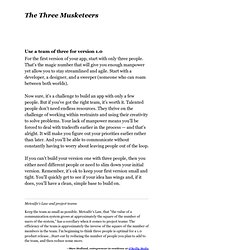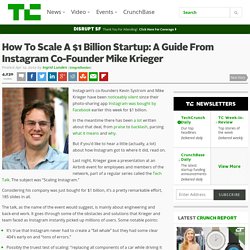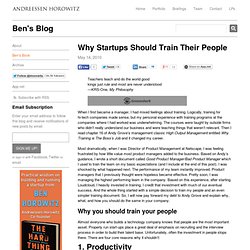

Who Owns Your UX Philosophy? Feld Thoughts. I’ve been in three board meetings in the last month where it was painfully apparent that there wasn’t a person in the company who owned the UX philosophy of the product.

I’m explicitly saying “UX” (user experience) rather than “UI” (user interface) as each company had an excellent designer and the application looked great. But the UX broke down quickly, especially as you went from novice first time user to experienced user. Now, it’s not that the apps sucks. In each case, the apps ranged from good to great. They had huge amount of functionality, did unique things that other apps didn’t do, and solved a clear set of problems in a compelling way. But each had a jumble of different ways of doing things. Sometimes I’d click on a label to take an action; other times I’d click on a text description of the action. When I start feeling uncomfortable with UX, I start counting extra key and mouse actions. In each of the companies, there is an excellent VP of Engineering. The Three Musketeers. For the first version of your app, start with only three people.

That's the magic number that will give you enough manpower yet allow you to stay streamlined and agile. How Stripe built one of Silicon Valley’s best engineering teams.
Agile... Scrum (méthode) Pour les articles homonymes, voir Scrum.

Scrum est un schéma d’organisation de développement de produits complexes. Il est défini par ses créateurs comme un « cadre de travail holistique itératif qui se concentre sur les buts communs en livrant de manière productive et créative des produits de la plus grande valeur possible ». Scrum est considéré comme un groupe de pratiques répondant pour la plupart aux préconisations du Manifeste Agile.
L'infrastructure de développement s'appuie sur le découpage d'un projet en boîtes de temps, nommées « sprints ». Les sprints peuvent durer entre quelques heures et un mois (avec un sprint médian à deux semaines). La création de frameworks de développement logiciel hybrides couplant Scrum et d'autres frameworks est commune puisque Scrum ne couvre pas le cycle de développement de produit. En 1995, Ken Schwaber présente une courte communication décrivant les fondements de ce qui deviendra la méthode Scrum à l'OOPSLA[3].
Méthode agile. Daily stand-up, rituel quotidien des méthodes agiles.

En ingénierie logicielle, les. Here’s How Spotify Scales Up And Stays Agile: It Runs ‘Squads’ Like Lean Startups. What’s the secret to staying fresh, lean and mean when you’re a hot tech company on a fast growth trajectory?

A fascinating document brought to our attention today today by Andrew Mager, hacker advocate at Spotify, answers that question in some detail by telling us how the music streaming juggernaut does it: by dividing up its business into small clusters — which it calls ‘squads’ — and running each like a startup in its own right. We’ve embedded the document below. The information here is all the more relevant since this week we saw that Spotify is now finally making a move on to the web. When that is fully live, it could open Spotify up to another big growth boom from a whole new population of users beyond the 15 million early adopters (4 million of which pay) who currently use its mobile and desktop clients. How To Scale A $1 Billion Startup: A Guide From Instagram Co-Founder Mike Krieger. Instagram’s co-founders Kevin Systrom and Mike Krieger have been noticeably silent since their photo-sharing app Instagram was bought by Facebook earlier this week for $1 billion.

In the meantime there has been a lot written about that deal, from praise to backlash, parsing what it means and why. But if you’d like to hear a little (actually, a lot) about how Instagram got to where it did, read on. Last night, Krieger gave a presentation at an Airbnb event for employees and members of the network, part of a regular series called the Tech Talk. The subject was “Scaling Instagram.” Considering his company was just bought for $1 billion, it’s a pretty remarkable effort, 185 slides in all. Why Startups Should Train Their People. Teachers teach and do the world goodkings just rule and most are never understood—KRS-One, My Philosophy When I first became a manager, I had mixed feelings about training.

Logically, training for hi-tech companies made sense, but my personal experience with training programs at the companies where I had worked was underwhelming. The courses were taught by outside firms who didn’t really understand our business and were teaching things that weren’t relevant. Then I read chapter 16 of Andy Grove’s management classic High Output Management entitled Why Training is The Boss’s Job and it changed my career.
Most dramatically, when I was Director of Product Management at Netscape, I was feeling frustrated by how little value most product managers added to the business. Why you should train your people Almost everyone who builds a technology company knows that people are the most important asset. 1. Training is, quite simply, one of the highest-leverage activities a manger can perform. 2. 3. 4. Arielseidman. At Mango Labs we are busy building something new.

As we build we are always meeting face-to-face with existing and new potential customers. Over the past two days we met with ten potential customers and tomorrow we will meet with an additional fourteen. We put our product in front of them and then actively watch and listen to them. The entire process is tiring yet fills us with so much energy. The startup dream team. The trick Max Levchin used to hire the best engineers at PayPal. Evernote shares model. Why Power Stifles Innovation.
When it comes to innovation, we know that open-mindedness, deferring judgment, including diverse inputs from diverse people, and fostering collaboration inside and outside the organization are all success factors when going for big ideas that will make a big difference.

But recent research from USC’s Marshall School of Business in collaboration with the London Business School, University of Illinois, and Northwestern University reveals an alarming finding for any leader with an innovation agenda: when we feel a sense of personal power, we overestimate our ability to make good decisions, which can lead to higher risk-taking coupled with poor decision-making. Researchers conducted a series of experiments that put people in touch with their feelings of power or powerlessness.
Subjects completed a “leadership questionnaire” and received one of two random results; they were told either they had an aptitude for strong leadership or, they “may not be as competent as others.”